Papers by Arwid Daugschies

DTW. Deutsche tierärztliche Wochenschrift, 2004
Ronidazol is often used in racing pigeons for the treatment of Trichomonas infections and disease... more Ronidazol is often used in racing pigeons for the treatment of Trichomonas infections and diseases. Therefore, in this study, the compatibility of the drug was examined by oral application over 7 days. For this purpose a randomized blind study was performed using four different groups (control group, 10 mg = therapy-group, 20 mg = double-dose-group and 40 mg = high-dose-group) of pigeons (Columba livia f. domestica) with 6 male and 6 female birds each. All birds were clinically healthy and between 6 and 12 weeks of age. The application of ronidazol at a dose of 10 mg/racing pigeon did show no side-effect within the duration of the study, e.g. no influence could be seen on clinical, haematological, blood-chemical and pathological parameters. Low-to middle-grade clinical alterations of the gastro-intestinal tract occurred in the high-dose group at day 6 and 7 of the application of the drug. Therefore a fourfold overdosing of ronidazol should be avoided.
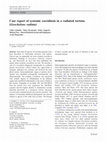
Parasitology research, 2008
More than 30 species of coccidian parasites have been described in Chelonidae (tortoises and turt... more More than 30 species of coccidian parasites have been described in Chelonidae (tortoises and turtles). Eimeria spp. are apparently the most common coccidia in chelonians. Findings of Caryospora cheloniae, Isospora sp., and Mantonella sp. have also been published, but reports about systemic coccidiosis are rare. We describe a case of a coccidiosis diagnosed cytologically in a radiated tortoise (Geochelone radiata) which was captive-bred in Germany. Infection was systemic and involved the lymphoid system. Intracytoplasmatic stages of parasite development were identified cytologically, histologically, and ultrastructurally. The systemic coccidiosis was associated with variable degrees of inflammation in the different organs and contributed substantially to the cause of death in this tortoise. Fragments of coccidian 18S- and 28S-rRNA from the tortoise liver were sequenced; the 18S-rRNA sequence had the highest identity to intranuclear coccidia described previously in a travancore tortoise (Intestudo forstenii) and a leopard tortoise (Geochelone pardalis). The analysis of maximum likelihood phylogenetic tree showed relation to species of the order Sarcocystidae. The biology of these coccidia and the route of infection in this case remained unclear.
Parasitology Research, 2013
The chorioallantoic membrane (CAM) of chicken embryo eggs is a suitable model for viral and bacte... more The chorioallantoic membrane (CAM) of chicken embryo eggs is a suitable model for viral and bacterial infections. In the present study, a new approach for testing the pathogenesis and virulence of Clostridium perfringens and Eimeria tenella dual infections as a model using the CAM of embryonated chicken eggs was developed. For this purpose, 24 specific pathogen-free (SPF) embryonated chicken eggs were divided into four groups (n=6) and designated group E, group CP, group CPE, and NC. Sporozoites of E. tenella (20,000 sporozoites) were inoculated into 10-day-old embryonated SPF chicken eggs (groups E and CPE) via allantoic sac route. At 15-day-old, eggs of groups CP and CPE were infected with 10 4 cfu C. perfringens via the same route. Assessment of pathogenicity was assessed using gross and histopathological lesions.
Parasitology Research, 2014
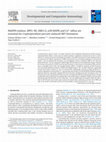
Developmental and comparative immunology, Jan 27, 2015
Cryptosporidium parvum causes a zoonotic infection with worldwide distribution. Besides humans, c... more Cryptosporidium parvum causes a zoonotic infection with worldwide distribution. Besides humans, cryptosporidiosis affects a wide range of animals leading to significant economic losses due to severe enteritis in neonatal livestock. Neutrophil extracellular trap (NET) formation has been demonstrated as an important host effector mechanism of PMN acting against several invading pathogens. In the present study, C. parvum-mediated NET formation was investigated in human and bovine PMN in vitro. We here demonstrate that C. parvum sporozoites indeed trigger NET formation in a time-dependent manner. Thereby, the classical characteristics of NETs were demonstrated by co-localization of extracellular DNA with histones, neutrophil elastase (NE) and myeloperoxidase (MPO). A significant reduction of NET formation was measured following treatments of PMN with NADPH oxidase-, NE- and MPO-inhibitors, confirming the key role of these enzymes in C. parvum-induced NETs. Additionally, sporozoite-trigg...

Veterinary parasitology, Jan 25, 2003
In a 5-year survey regarding its prevalence and importance in five German state veterinary labora... more In a 5-year survey regarding its prevalence and importance in five German state veterinary laboratories Cryptosporidium was diagnosed annually in 19-36% of faecal samples either submitted to the laboratories or taken post mortem. In approximately half of the cases no other enteropathogens were detected. However, only 73% of 30 laboratories participating in a questionnaire survey routinely tested for this parasite, and the majority of researchers considered cryptosporidiosis to be of minor importance. In a placebo-controlled field study 152 suckling calves were treated daily against cryptosporidiosis either with sulfadimidine or with halofuginone (Halocur, Intervet) over 1 week. Treatment by oral drench started at the onset of diarrhoea in the herd. Oocyst excretion, faecal consistency and health status were recorded five times for a 3-week period. Oocyst excretion peaked 7-14 days in the placebo group after the onset of diarrhoea, and during that period prevalence and intensity of e...
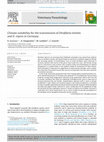
Veterinary parasitology, Jan 15, 2014
Recently concerns are increasing that dirofilarial nematodes may spread from endemic areas in sou... more Recently concerns are increasing that dirofilarial nematodes may spread from endemic areas in southern, eastern and central Europe to countries in northern regions of Europe. The increasing number of autochthonous cases of canine Dirofilaria repens infections in Germany indicates that worms of this genus may invade new areas, and climate change may be a key factor in this scenario. Thus analysis of long term development of regional temperature is a pivotal factor in risk analysis related to transmission of these worms. Such information is important for suggestions of counteracting strategies, such as definition of periods of increased transmission risk and, consequently, time slots most suited for preventative measures. In this study, mean daily temperature data from 34 geographical clustered weather stations representing all parts of Germany were analyzed. It is concluded that the increasing trend for average daily temperatures observed in the period from 1984 to 2013 has led to cl...

Advances in parasitology, 2000
Eicosanoids are lipid mediators with multiple functions in vertebrate tissues and invertebrate or... more Eicosanoids are lipid mediators with multiple functions in vertebrate tissues and invertebrate organisms. In this review the roles of eicosanoids--mostly prostaglandins (PGs), thromboxanes and leukotrienes--in parasite physiology and host-parasite interactions are discussed. PGs are present in the saliva of blood-sucking arthropods facilitating feeding by increasing local blood flow and prolonged attachment of ticks by immune suppression. Release of various eicosanoids has also been demonstrated for a number of protozoan and metazoan endoparasites. These substances appear to play a role in penetration, immune suppression, inflammation or modulation of haemostasis, enabling parasite invasion and establishment. Moreover, endogenous eicosanoids serve various functions in parasite metabolism and physiology. In many parasitic infections eicosanoids are involved in host pathology, e.g. granuloma formation, coagulopathy, secretory diarrhoea, or fever. Immune suppression by induction of PG ...

Veterinary Parasitology, 1999
Mixed fecal samples of 264 litters from five piglet production farms (155-238 sows/farm) were inv... more Mixed fecal samples of 264 litters from five piglet production farms (155-238 sows/farm) were investigated three times during the suckling period for the occurrence of Isospora suis over the period of 1 year. On all five farms Isopora suis was found to be a common endoparasite with infection rates being highest in litters of 3-4 weeks of age. By the end of the third investigation period the cumulative infection rate was 53.8% of the litters ranging from 20.0% to 81.5% for the single farms. During the suckling period the infection rate increased from 18.6% to 32.6% and then to 37.7%. Diarrhea was present in 66.3% of the sampled litters with the highest rates at the end of the suckling period. 63.4% of the litters which showed diarrhea and 34.8% of those without diarrhea excreted I. suis within the study period. Diarrhea was recorded for 78.2% of the I. suis-positive litters and for 52.5% of the Isospora-negative litters. In summer and fall the occurrence of I. suis was higher (66.3% and 61.0%, respectively) than in spring and winter (47.7% and 37.9%, respectively). In litters with diarrhea and pathogenic E. coli I. suis often occurred simultaneously. Above-average hygiene measures and mainly perforated pen floors seemed to lower the risk of isosporosis. With the exception of Strongyloides ransomi other parasites were not found in the fecal samples of suckling piglets. Two specialized piglet rearing farms, a conventional large-scale rearing unit and a farm managed according to the segregated early weaning (SEW) system were examined three times during the 6-7 week rearing period. In both units I. suis was common, but was not correlated with diarrhea. In the SEW unit the infection rates decreased from 37.5% to 20.2% and to 4.1%, while the infection rate in the conventional unit slightly increased from the first (17.2%) to the second (21.9%) investigation and stayed at this level at the third sampling.
Experimental Parasitology, 2014
International Journal for Parasitology, 2000
Total methylated fatty acid patterns of various developmental stages (third-stage larvae (L3), L3... more Total methylated fatty acid patterns of various developmental stages (third-stage larvae (L3), L3 and fourth-stage larvae (L4) cultured in vitro, L4 and female and male adults derived from intestinal contents) of the porcine nodular worms Oesophagostomum dentatum and Oesophagostomum quadrispinulatum and their cultivation medium were analysed by gas chromatography using Microbial Identification computer software. Fatty acids ranging from C-12 to
Journal of Veterinary Medicine Series B, 2005

Journal of Veterinary Medicine Series B, 2002
In order to evaluate the prevalence of Isospora suis in conventional piglet production in Germany... more In order to evaluate the prevalence of Isospora suis in conventional piglet production in Germany, pooled faecal samples from 327 pig litters from 18 pig production units (20-320 sows each) were examined. At least 10 litters from each farm were investigated. I. suis was present on 83% of the farms and 42.5% of the litters, the infection rate being highest in the third week of age (48.2%). I. suis was found more frequently in samples of diarrhoea than in firm faeces (49.2% compared to 22.2%). Twenty naturally infected piglets from six of these farms underwent examination post mortem, including histology, virology and bacteriology. Histological examination revealed atrophy of the villi in various degrees, mild crypt hyperplasia, fusion of the villi, metaplastic epithelium, erosions and necrosis, especially in the medium and the posterior jejunum and in the ileum. Asexual and sexual developmental stages of the parasite were found in varying numbers in the epithelium of the whole of the small intestine. Bacteria and viruses were mostly excluded as the cause of diarrhoea, and it was concluded that I. suis was the primary pathogen inducing distinct changes and clinical symptoms of diarrhoea.
Journal of Veterinary Medicine Series B, 2004
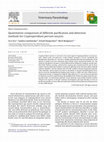
Veterinary Parasitology, 2011
Cryptosporidium parvum (C. parvum) is the causal agent of cryptosporidiosis in many animals, main... more Cryptosporidium parvum (C. parvum) is the causal agent of cryptosporidiosis in many animals, mainly cattle, and possesses a high zoonotic potential. It occurs worldwide and ubiquitously. Detection of C. parvum is mainly performed directly but purification of the oocysts is useful to increase sensitivity and to obtain oocyst material for further use. The study was designed to compare (a) three different direct diagnostic methods, namely modified Ziehl-Neelsen staining, carbol fuchsin staining and conventional PCR, and (b) three routine oocyst purification methods, in particular flotation with saturated sodium chloride solution, Sheather's sucrose solution and a Percoll ® gradient. During comparison of purification methods, special regard was paid to the ability to separate morphologically intact oocysts from the morphologically degenerated fraction or viable from non-viable oocysts, respectively. Results: (a) Diagnostic methods: Most effective in C. parvum oocysts detection in calf faeces was PCR; carbol fuchsin and modified Ziehl-Neelsen stainings achieved comparable results. (b) Purification methods: Oocyst flotation using sodium chloride solution showed to be superior to Percoll ® gradient centrifugation and sugar flotation in terms of purification quality, recovery efficacy (yield) and reduction of the proportion of degenerated or non-viable oocysts.

Veterinary Parasitology, 2002
Future prophylaxis needs new concepts, including natural disease resistance of hosts against infe... more Future prophylaxis needs new concepts, including natural disease resistance of hosts against infectious agents. Genomic approaches to detect and improve disease resistance in farm animals and the molecular mechanisms involved in host-parasite interactions depend to a high degree on the trait differences between founder breeds, i.e. on the animal model. The present study evaluates differences in susceptibility/resistance against Sarcocystis miescheriana in the European Pietrain (PI) and the Chinese Meishan (ME) pig breeds, based on 25 individuals, infected orally with 5×10 4 sporocysts of S. miescheriana. Significant differences appeared in clinical, serological, haematological and parasitological findings. The major discriminating period post infection (p.i.) was between days 42 and 45. Severity of signs was negatively correlated with specific immunoglobulin titres during the first 3 weeks p.i. and positively with the load of bradyzoites in muscle tissues of the pigs. Loads of bradyzoites in muscle tissues were 20 times higher in PI than in ME. Sarcocystis-specific differences between the two breeds were in the range of 1-2 standard deviations. The study lays the foundation for further experiments to analyse chromosomal regions, candidate genes, and thus the molecular basis of Sarcocystis susceptibility/resistance as a model for host-parasite interaction in protozoan infectious disease.
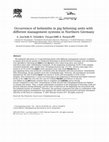
Veterinary Parasitology, 2001
The helminth infections on 13 pig fattening farms with different management systems (complete or ... more The helminth infections on 13 pig fattening farms with different management systems (complete or partial all-in-all-out system or continuous fattening) in North-Western Germany were investigated over at least three fattening periods. Pooled faecal samples were taken from pens once before and three times after anthelmintic treatment. At the beginning of fattening 34.9% of the samples contained helminth eggs, mainly from Oesophagostomum spp. (27.5%). Ascaris suum eggs were found in 10.5% of the samples, while other parasites were only rarely found. The number of pig-supplying farms was positively correlated with the helminth infection prevalence. Immediately after deworming, all pen samples were free of helminth eggs. However, the prevalences increased again, and by the end of fattening A. suum was found in 33.0% and strongylids in 6.0% of the samples. Pens harbouring A. suum-excreting pigs at the beginning of fattening had higher infection levels at the end, and this was also the case for nodular worms. The final prevalence of Ascaris was higher in partial exchange systems than in complete all-in-all-out systems and in old pig houses compared to new ones. Transmission of both Ascaris and Oesophagostomum was highest in autumn and winter. Thus, a single anthelmintic treatment at the beginning of fattening could not prevent infection during fattening, and the state of infection at the beginning was associated with the helminth burden at slaughter. Therefore, the purchase of parasite-free pigs in combination with appropriate hygiene management may minimise the initial infection pressure and keep subsequent infection of the herd at a minimum.

Veterinary Parasitology, 2003
In order to test various viability assays for Cryptosporidium parvum oocysts were used to infect ... more In order to test various viability assays for Cryptosporidium parvum oocysts were used to infect HCT-8 cells in vitro or baby mice. Infected cells were either stained with fluorescent anti-Cryptosporidium-antibody or lysed and subjected to C. parvum-specific PCR after 48 h. Titrations with infective oocysts were performed and compared to oocysts disinfected with Neopredisan for 2 h at varying concentrations. Caecal smears and histological sections from infected animals were examined in parallel. The number of foci of parasite development in vitro after immunofluorescent staining correlated well with the infection dose. PCR was less quantifiable and the results were not always reproducible, especially when low infection doses were used. Disinfection resulted in a dose-dependent reduction of oocyst infectivity when compared to the controls in all three assays. The infection of cells cultured in vitro with oocysts of C. parvum provides a suitable tool for the estimation of viability after treatment with chemical disinfectants. Immunofluorescence is easy to perform and gives quantitative results, while PCR-based detection of parasite DNA, although possible, requires the use of more sophisticated tools for quantification.
Parasitology Research, 2013
Information on the efficacy of pharmaceutical protocols for the prevention of the major canine fi... more Information on the efficacy of pharmaceutical protocols for the prevention of the major canine filarioses (i.e., Dirofilaria immitis , Dirofilaria repens , and Acanthocheilonema reconditum ) under natural conditions is scant. Chemoprophylaxis for canine filarioses under field conditions deserves to be studied more fully and information about vector biology, ecology, and seasonality has to be well appreciated to correctly set control protocols. It is advisable that researchers planning field trials to assess the efficacy of any product for the prevention of canine vectorborne diseases should consider different eco-epidemiological aspects of diseases, including their dynamics of transmission, which are driven by complex interactions between animals, pathogens, and vectors.
Parasitology Research, 2001
Parasites from swine faeces were examined for autofluorescence. Oocysts of Eimeria polita, E. sca... more Parasites from swine faeces were examined for autofluorescence. Oocysts of Eimeria polita, E. scabra and Isospora suis, cysts of Balantidium coli and eggs of Oesophagostomum dentatum, Strongyloides ransomi and Trichuris suis (but not those of Ascaris suum) emitted light after excitation with UV light. I. suis oocyst counts in McMaster chambers utilising autofluorescence were compared to those from conventional bright field microscopy. Similarly, faecal smears containing I. suis were examined using the same techniques. Autofluorescence was superior to bright field microscopy in detecting oocysts after flotation and was highly significantly more sensitive when direct smears were examined.

Uploads
Papers by Arwid Daugschies